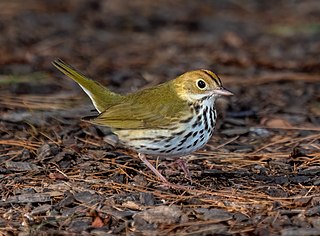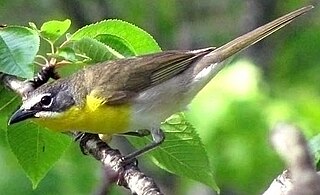
The New World warblers or wood-warblers are a group of small, often colorful, passerine birds that make up the family Parulidae and are restricted to the New World. The family contains 120 species. They are not closely related to Old World warblers or Australian warblers. Most are arboreal, but some, like the ovenbird and the two waterthrushes, are primarily terrestrial. Most members of this family are insectivores.

The dark-eyed junco is a species of junco, a group of small, grayish New World sparrows. The species is common across much of temperate North America and in summer it ranges far into the Arctic. It is a variable species, much like the related fox sparrow, and its systematics are still not completely resolved.

The bay-breasted warbler is a small species of songbird in the New World warbler family, Parulidae. It is one of thirty-four species in the diverse genus Setophaga. Like all songbirds, or passerines, the species is classified in the order Passeriformes.

The black-and-white warbler is a species of New World warbler, and the only member of its genus, Mniotilta. It breeds in northern and eastern North America and winters in Florida, Central America, and the West Indies down to Peru. This species is a very rare vagrant to western Europe.

The ovenbird is a small songbird of the New World warbler family (Parulidae). This migratory bird breeds in eastern North America and winters in Central America, many Caribbean islands, Florida and northern Venezuela.

The Nashville warbler is a small songbird in the New World warbler family, found in North and Central America. It breeds in parts of the northern and western United States and southern Canada, and migrates to winter in southern California and Texas, Mexico, and the north of Central America. It has a gray head and a green back, and its underparts are yellow and white.

The yellow-breasted chat is a large songbird found in North America, and is the only member of the family Icteriidae. It was once a member of the New World warbler family, but in 2017, the American Ornithological Society moved it to its own family. Its placement is not definitively resolved.

The black-throated gray warbler or black-throated grey warbler is a passerine bird of the New World warbler family Parulidae. It is 13 cm (5.1 in) long and has gray and white plumage with black markings. The male has the bold black throat of its name, and black stripes on its head, as well as black streaks on its flanks; the female is a paler version of the male, with a white throat and less distinct black markings on the flanks and wings. It breeds in western North America from British Columbia to New Mexico, and winters in Mexico and the southwestern United States. The habitats it prefers are coniferous and mixed forests and scrubland, especially those with pinyon pines, junipers, sagebrush, and oaks. Its nest is an open cup of plant fibers lined with feathers, built a few metres from the ground in the branches of a tree or shrub. Three to five eggs are laid, and young are fed by both parents. Common in its breeding range, it does not seem to be seriously threatened by human activities, unlike many migratory warblers.

The painted redstart or painted whitestart is a species of New World warbler found in mountainous areas across inland Central America. They are among the largest warblers, reaching the length of 6 inches (150 mm), tail included. Adult birds have glossy black plumage, with white strips on the wing and a bright red belly. Female and male birds have similar appearance. Female painted redstarts have a rare feature of being as good singers as the males.

Grace's warbler is a small New World warbler that specializes in pine woods.

Passerida is, under the Sibley-Ahlquist taxonomy, one of two parvorders contained within the suborder Passeri. While more recent research suggests that its sister parvorder, Corvida, is not a monophyletic grouping, the Passerida as a distinct clade are widely accepted.

The red warbler is a small passerine bird of the New World warbler family Parulidae endemic to the highlands of Mexico, north of the Isthmus of Tehuantepec. It is closely related to, and forms a superspecies with, the pink-headed warbler of southern Mexico and Guatemala. There are three subspecies, found in disjunct populations, which differ in the color of their ear patch and in the brightness and tone of their body plumage. The adult is bright red, with a white or gray ear patch, depending on the subspecies; young birds are pinkish-brown, with a whitish ear patch and two pale wingbars.

The pink-headed warbler is a small passerine bird found in the southwestern highlands of Guatemala and the central and southeastern highlands of the Mexican state of Chiapas. The adult is primarily red, with a silvery-pink head and chest. It is a fairly common to common resident of humid to semi-humid pine-oak, pine-evergreen and evergreen forest and edge, at altitudes ranging from 1,800–3,500 m (5,900–11,500 ft) above sea level.

The hepatic tanager is a medium-sized American songbird. Formerly placed in the tanager family (Thraupidae), it and other members of the genus Piranga are now classified in the cardinal family (Cardinalidae). The species's plumage and vocalizations are similar to other members of the cardinal family.

The wrenthrush or zeledonia is a unique species of nine-primaried oscine bird which is endemic to Costa Rica and Panama.

The Cuban warblers are a genus, Teretistris, and family, Teretistridae, of birds endemic to Cuba and its surrounding cays. Until 2002 they were thought to be New World warblers, but DNA studies have shown that they are not closely related to that family. The family consists of two species, the yellow-headed warbler and the Oriente warbler. Both species are found in forest and scrub, with the yellow-headed warbler ranging in the west of the island and the Oriente warbler in the east. The Cuban warblers are 13 cm (5.1 in) long and have similar yellow and grey plumage.

Ergaticus was a genus of New World warblers — small passerine birds found only in the Americas. It was subsumed into Cardellina in 2011. The name is the Latinized version of the Ancient Greek ergatikos, meaning "willing or able to work". The genus contains two sister species: the red warbler, which is endemic to the Mexican highlands north of the Isthmus of Tehuantepec, and the pink-headed warbler, which is found south of the Isthmus, from the highlands of Chiapas, Mexico down into Guatemala. Though they are separated by geography and differ considerably in plumage, the two have sometimes been considered to be conspecific.





















